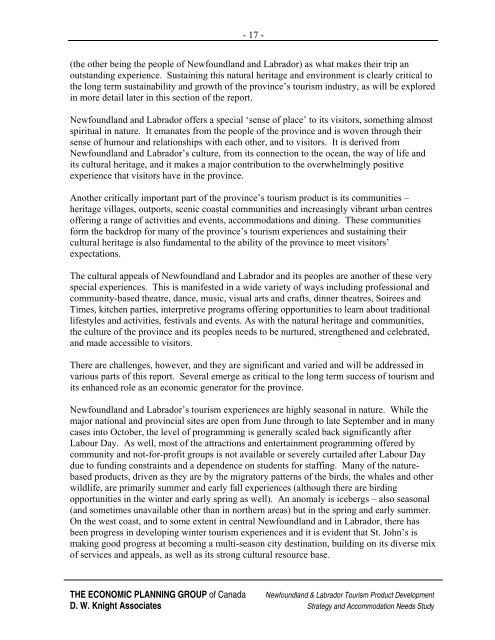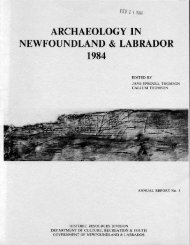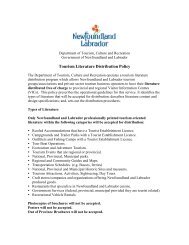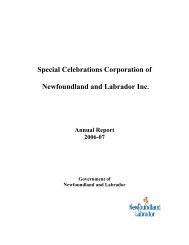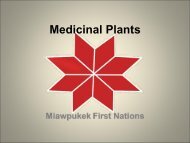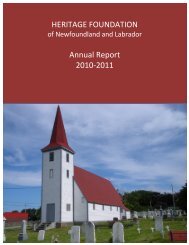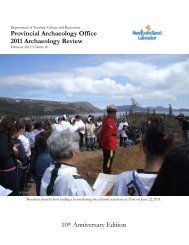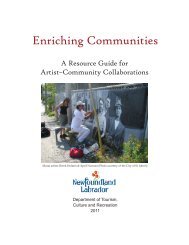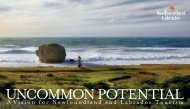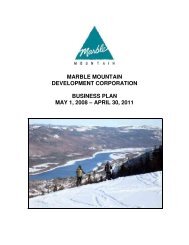Newfoundland and Labrador Product Development Strategy
Newfoundland and Labrador Product Development Strategy
Newfoundland and Labrador Product Development Strategy
- No tags were found...
Create successful ePaper yourself
Turn your PDF publications into a flip-book with our unique Google optimized e-Paper software.
- 17 -(the other being the people of <strong>Newfoundl<strong>and</strong></strong> <strong>and</strong> <strong>Labrador</strong>) as what makes their trip anoutst<strong>and</strong>ing experience. Sustaining this natural heritage <strong>and</strong> environment is clearly critical tothe long term sustainability <strong>and</strong> growth of the province’s tourism industry, as will be exploredin more detail later in this section of the report.<strong>Newfoundl<strong>and</strong></strong> <strong>and</strong> <strong>Labrador</strong> offers a special ‘sense of place’ to its visitors, something almostspiritual in nature. It emanates from the people of the province <strong>and</strong> is woven through theirsense of humour <strong>and</strong> relationships with each other, <strong>and</strong> to visitors. It is derived from<strong>Newfoundl<strong>and</strong></strong> <strong>and</strong> <strong>Labrador</strong>’s culture, from its connection to the ocean, the way of life <strong>and</strong>its cultural heritage, <strong>and</strong> it makes a major contribution to the overwhelmingly positiveexperience that visitors have in the province.Another critically important part of the province’s tourism product is its communities –heritage villages, outports, scenic coastal communities <strong>and</strong> increasingly vibrant urban centresoffering a range of activities <strong>and</strong> events, accommodations <strong>and</strong> dining. These communitiesform the backdrop for many of the province’s tourism experiences <strong>and</strong> sustaining theircultural heritage is also fundamental to the ability of the province to meet visitors’expectations.The cultural appeals of <strong>Newfoundl<strong>and</strong></strong> <strong>and</strong> <strong>Labrador</strong> <strong>and</strong> its peoples are another of these veryspecial experiences. This is manifested in a wide variety of ways including professional <strong>and</strong>community-based theatre, dance, music, visual arts <strong>and</strong> crafts, dinner theatres, Soirees <strong>and</strong>Times, kitchen parties, interpretive programs offering opportunities to learn about traditionallifestyles <strong>and</strong> activities, festivals <strong>and</strong> events. As with the natural heritage <strong>and</strong> communities,the culture of the province <strong>and</strong> its peoples needs to be nurtured, strengthened <strong>and</strong> celebrated,<strong>and</strong> made accessible to visitors.There are challenges, however, <strong>and</strong> they are significant <strong>and</strong> varied <strong>and</strong> will be addressed invarious parts of this report. Several emerge as critical to the long term success of tourism <strong>and</strong>its enhanced role as an economic generator for the province.<strong>Newfoundl<strong>and</strong></strong> <strong>and</strong> <strong>Labrador</strong>’s tourism experiences are highly seasonal in nature. While themajor national <strong>and</strong> provincial sites are open from June through to late September <strong>and</strong> in manycases into October, the level of programming is generally scaled back significantly afterLabour Day. As well, most of the attractions <strong>and</strong> entertainment programming offered bycommunity <strong>and</strong> not-for-profit groups is not available or severely curtailed after Labour Daydue to funding constraints <strong>and</strong> a dependence on students for staffing. Many of the naturebasedproducts, driven as they are by the migratory patterns of the birds, the whales <strong>and</strong> otherwildlife, are primarily summer <strong>and</strong> early fall experiences (although there are birdingopportunities in the winter <strong>and</strong> early spring as well). An anomaly is icebergs – also seasonal(<strong>and</strong> sometimes unavailable other than in northern areas) but in the spring <strong>and</strong> early summer.On the west coast, <strong>and</strong> to some extent in central <strong>Newfoundl<strong>and</strong></strong> <strong>and</strong> in <strong>Labrador</strong>, there hasbeen progress in developing winter tourism experiences <strong>and</strong> it is evident that St. John’s ismaking good progress at becoming a multi-season city destination, building on its diverse mixof services <strong>and</strong> appeals, as well as its strong cultural resource base.THE ECONOMIC PLANNING GROUP of Canada <strong>Newfoundl<strong>and</strong></strong> & <strong>Labrador</strong> Tourism <strong>Product</strong> <strong>Development</strong>D. W. Knight Associates <strong>Strategy</strong> <strong>and</strong> Accommodation Needs Study


